Context
Recently, the World Meteorological Organization (WMO) released the State of Global Climate Report 2023 (an annual State of the Climate Report).
About the World Meteorological Organization (WMO)
- The WMO is an intergovernmental organization with 193 member states and territories.
- India is one of the Member States of the WMO.
- Origin: WMO originated from the International Meteorological Organization, the roots of which were planted at the 1873 Vienna International Meteorological Congress.
- Establishment: WMO was established by ratifying the WMO Convention on 23rd March 1950.
- Specialized Agency: It became the specialized agency of the United Nations for Meteorology (weather and climate), operational hydrology and related geophysical sciences.
- Headquarters: Geneva, Switzerland.
|
State of Global Climate Report 2023: WMO Report
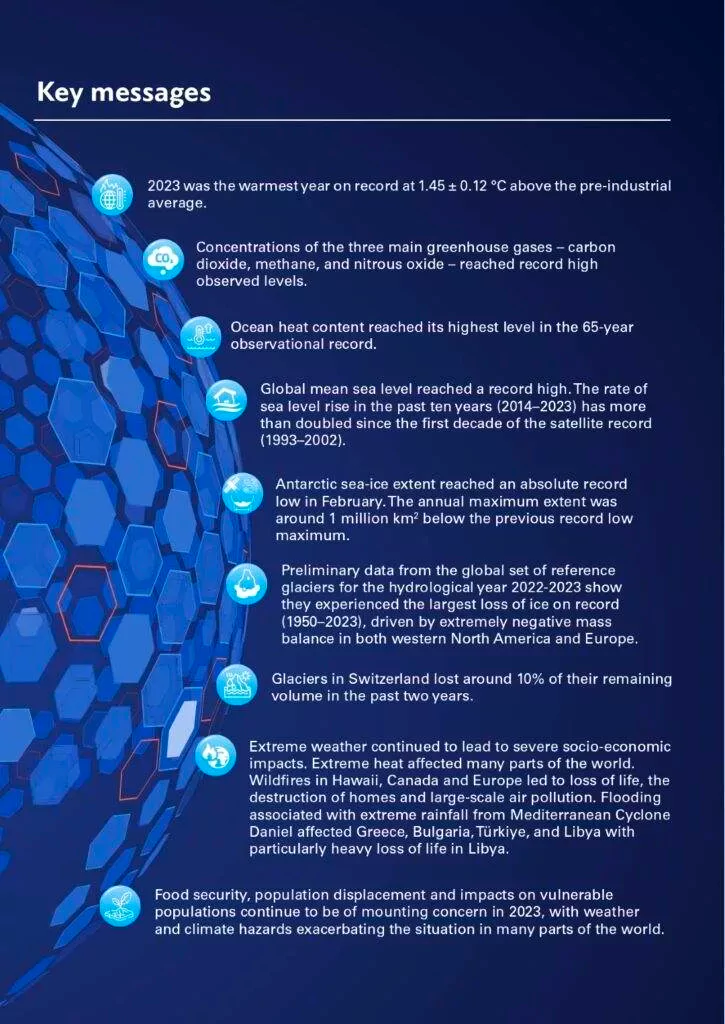
Key Findings of the State of Global Climate Report 2023
- Hottest Year: The State of Global Climate 2023 – WMO report found that 2023 was the hottest year. Numerous records for climate system indicators were broken.
- Witnessed Extreme Events: Extreme weather events hit many parts of the world in 2023, affecting water, food security, and human welfare. These included significant floods, extreme heat drought and associated wildfires.
-
On Climate Finance:
- In 2021/2022, global climate flows reached almost USD 1.3 trillion, nearly doubling compared to 2019/2020.
- Despite this growing momentum in climate finance, tracked flows represent only approximately 1% of global GDP.
- A High Financing Gap: Comparing tracked climate finance flows to estimated climate finance needs exposes a significant financing gap.
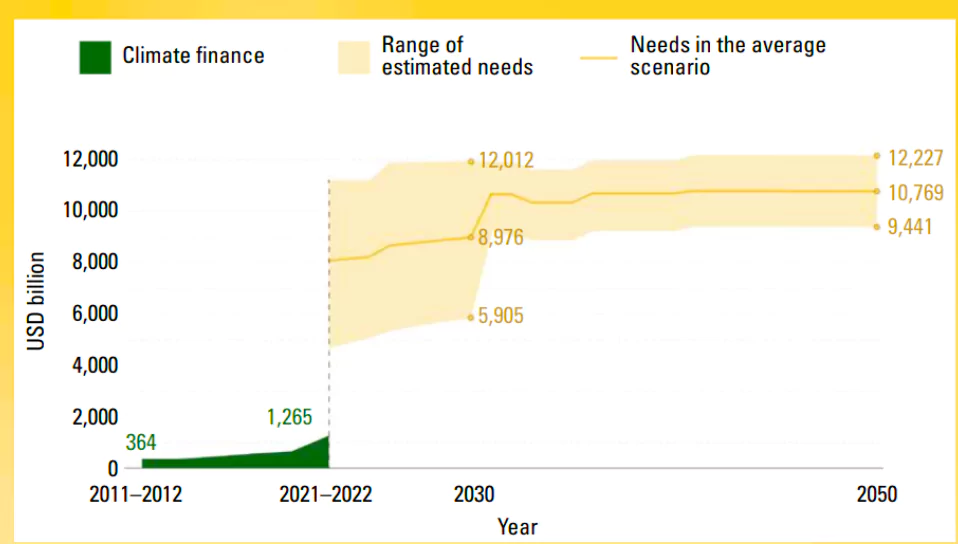 In an average scenario for a 1.5°C pathway, annual climate finance investments need to grow more than six times, reaching almost USD 9 trillion by 2030 and a further USD 10 trillion through 2050.
In an average scenario for a 1.5°C pathway, annual climate finance investments need to grow more than six times, reaching almost USD 9 trillion by 2030 and a further USD 10 trillion through 2050.
- Cost of Inaction: It is even higher than the financing gap. Aggregating over the period 2025-2100, the total cost of inaction is estimated at USD 1,266 trillion.
- It is likely to be a dramatic underestimate of the actual cost, as it does not capture losses to nature, biodiversity, and those induced by conflict and migration.
-
On Climate Monitoring and Renewable Energy:
-
- High Increase: In 2023, renewable capacity additions increased by almost 50% from 2022, for 510 gigawatts, the highest rate observed in the past two decades.
- Collective Action: At the recent Copenhagen Climate Ministerial, climate leaders and Ministers worldwide will gather for the first time since COP-28 in Dubai to push for accelerated climate action.
- Action Plans: Enhancing countries’ Nationally Determined Contributions (NDCs) ahead of the February 2025 deadline is expected to be high on the agenda, as well as delivering an ambitious agreement on financing at COP-29 to turn national plans into action.
- Challenge: Climate Action is being hampered by a lack of capacity to deliver and use climate services to inform national mitigation and adaptation plans, especially in developing countries.
About Status & Variation in the Key Indicators
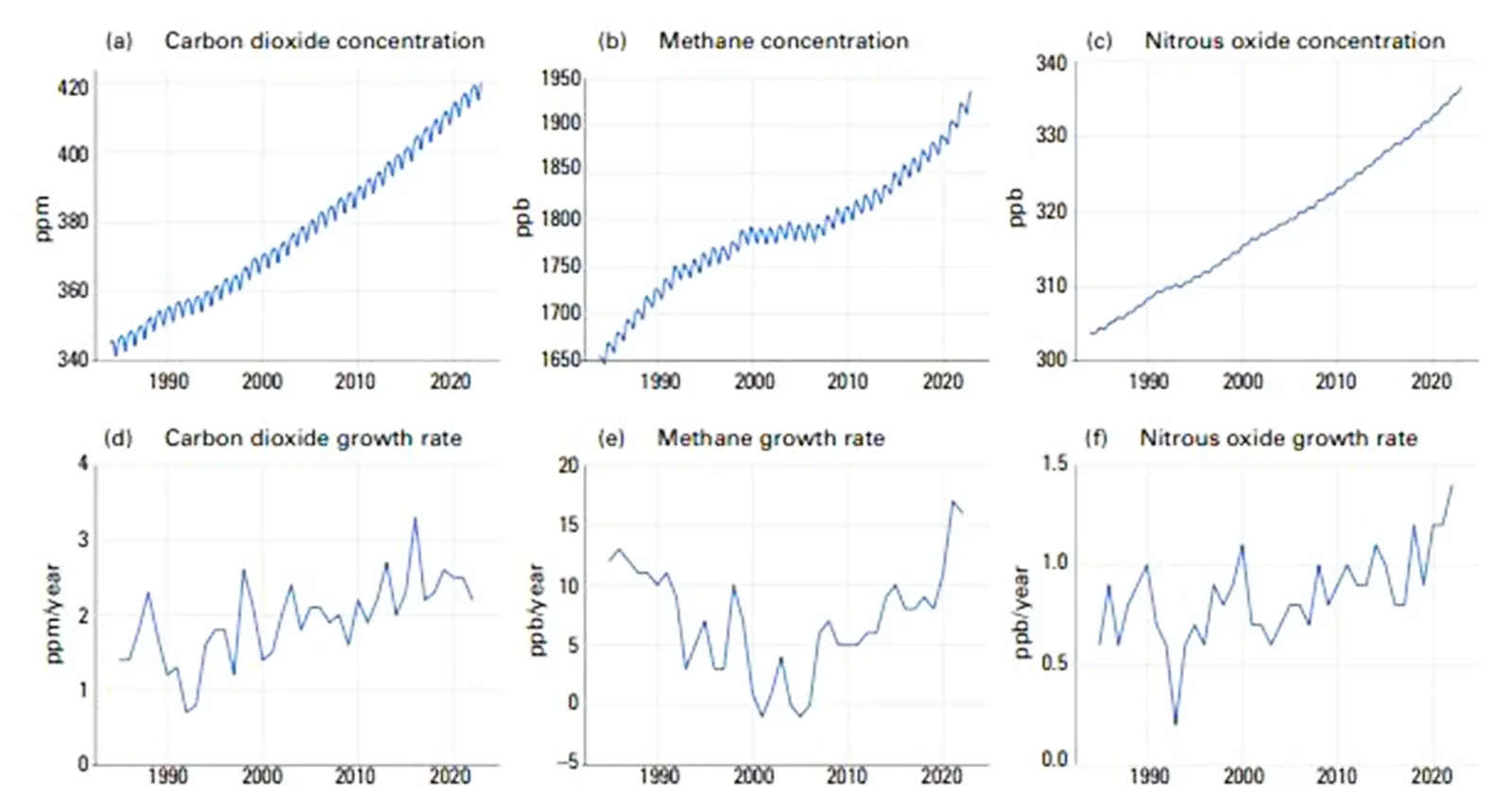
-
Greenhouse Gases:
- Causing Global Warming: The unprecedented levels of GHGs in the atmosphere are the main reasons for the planet’s rapid warming.
- Gases such as carbon dioxide, methane and nitrous oxide trap the incoming solar radiation in the atmosphere and contribute to global warming.
- Peak Concentration in 2022: The concentration of the aforementioned GHGs reached record-high observed levels in 2022.
- The rate of increase in nitrous oxide and methane was the highest and second highest, respectively.
- However, the rate of increase of carbon dioxide was slightly below the 10-year average.
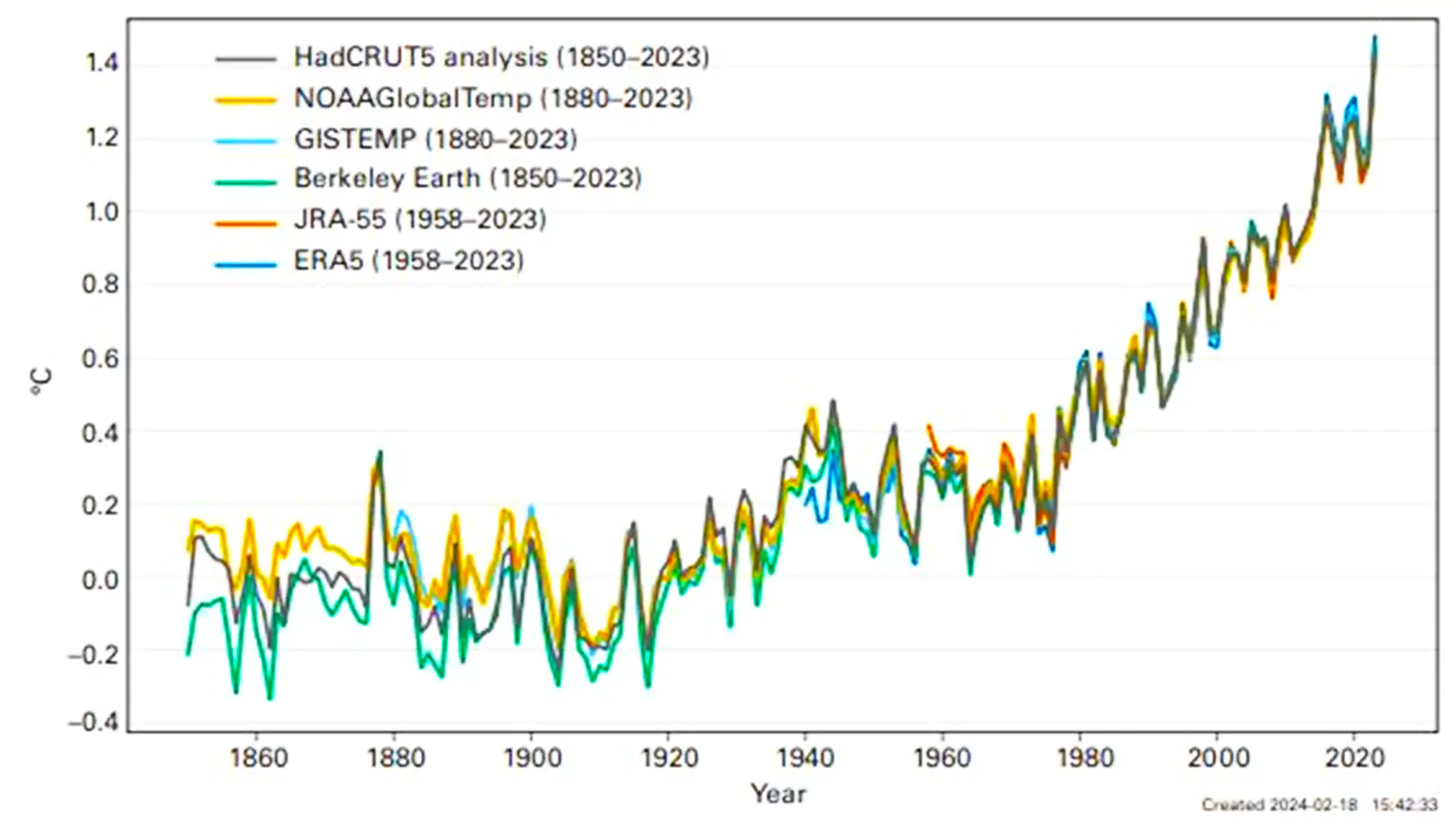
-
- High Rise: The global average near-surface temperature for 2023 raised to 1.45 degrees Celsius, the highest ever on record (above the pre-industrial levels).
- Responsible Factors: Rise in GHG concentrations in the atmosphere (primary reason), the shift from La Nina, and the onset of El Niño last year.
- The year 2023 marked the end of the three-year-long run of La Nina and the beginning of El Nino.
- El Nino and La Nina: These are the warm and cool phases of a recurring climate pattern across the tropical Pacific—the El Nino-Southern Oscillation (ENSO).
- El Nino refers to an abnormal warming of surface waters in the equatorial Pacific Ocean.
|
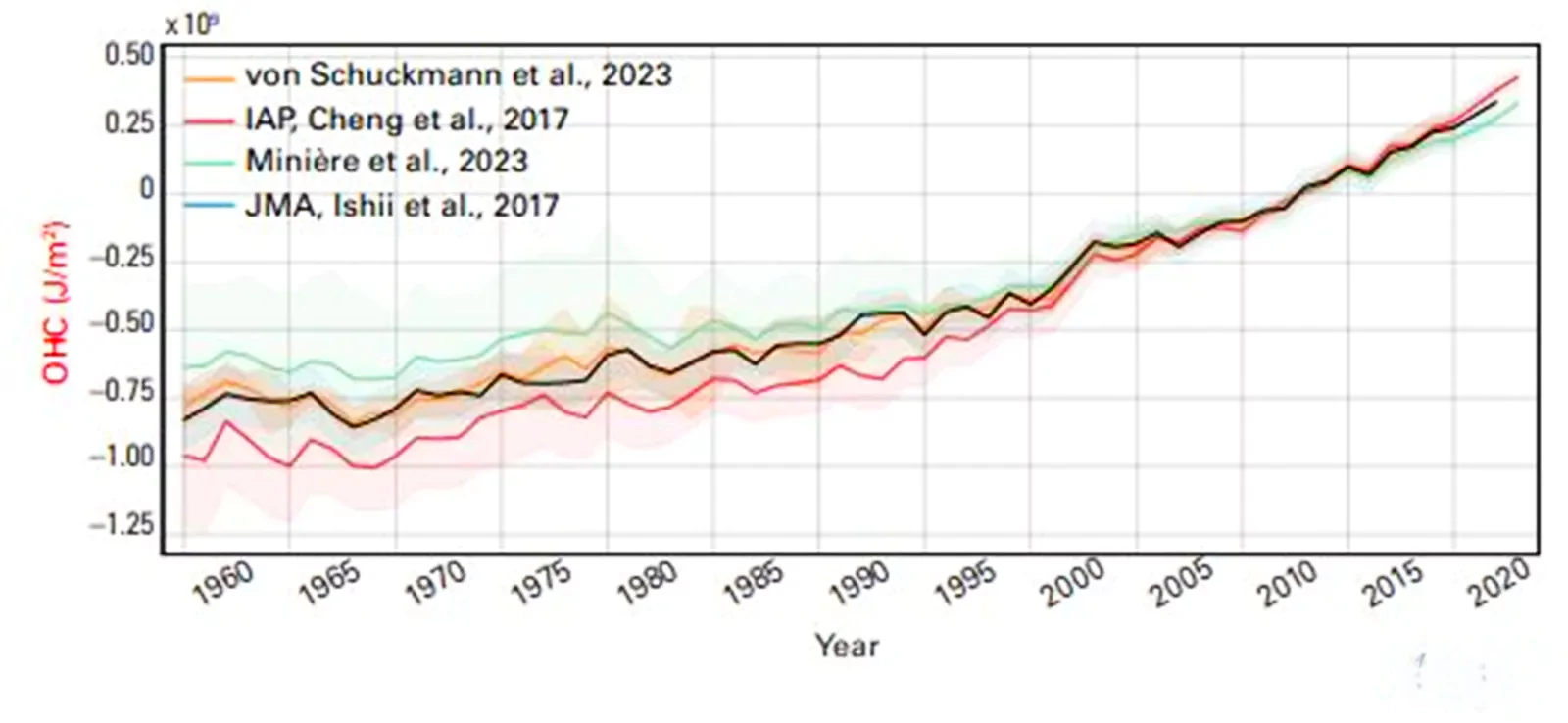
-
- Become Warmer: As the oceans have absorbed nearly 90% of the extra heat trapped by GHGs since 1971, they steadily become warmer and their heat content has increased.
- Highest Level: In 2023, the ocean heat content (OHC), the total amount of heat stored by the oceans, reached its highest level in the 65-year observational record.
- The global average sea-surface temperatures were also at a record level between late spring in the Northern Hemisphere and the end of the year.
- Non-Uniformity: The rate of warming is not the same everywhere. The strongest warming was recorded along the Southern, North Atlantic and the South Atlantic Oceans in 2023.
- Besides the Pacific Ocean warming, the Mediterranean Sea and Atlantic Ocean remained unusually warm.
-
Ocean Salinity:
- Observed Increase: Increase in acidity of the ocean is also increasing. The ocean absorbs around 25% of the annual anthropogenic carbon dioxide emissions to the atmosphere.
- Ocean Acidification: The GHGs react with seawater, resulting in decreased acid levels called “ocean acidification”.
- Negative Consequences: For organisms and ecosystem services, including food security, by reducing biodiversity, degrading habitats and endangering fisheries and aquaculture.
- Regional Variations: It is observed in the rate of change in ocean acidification, pattern, and scale. It called for high-resolution, long-term observation.
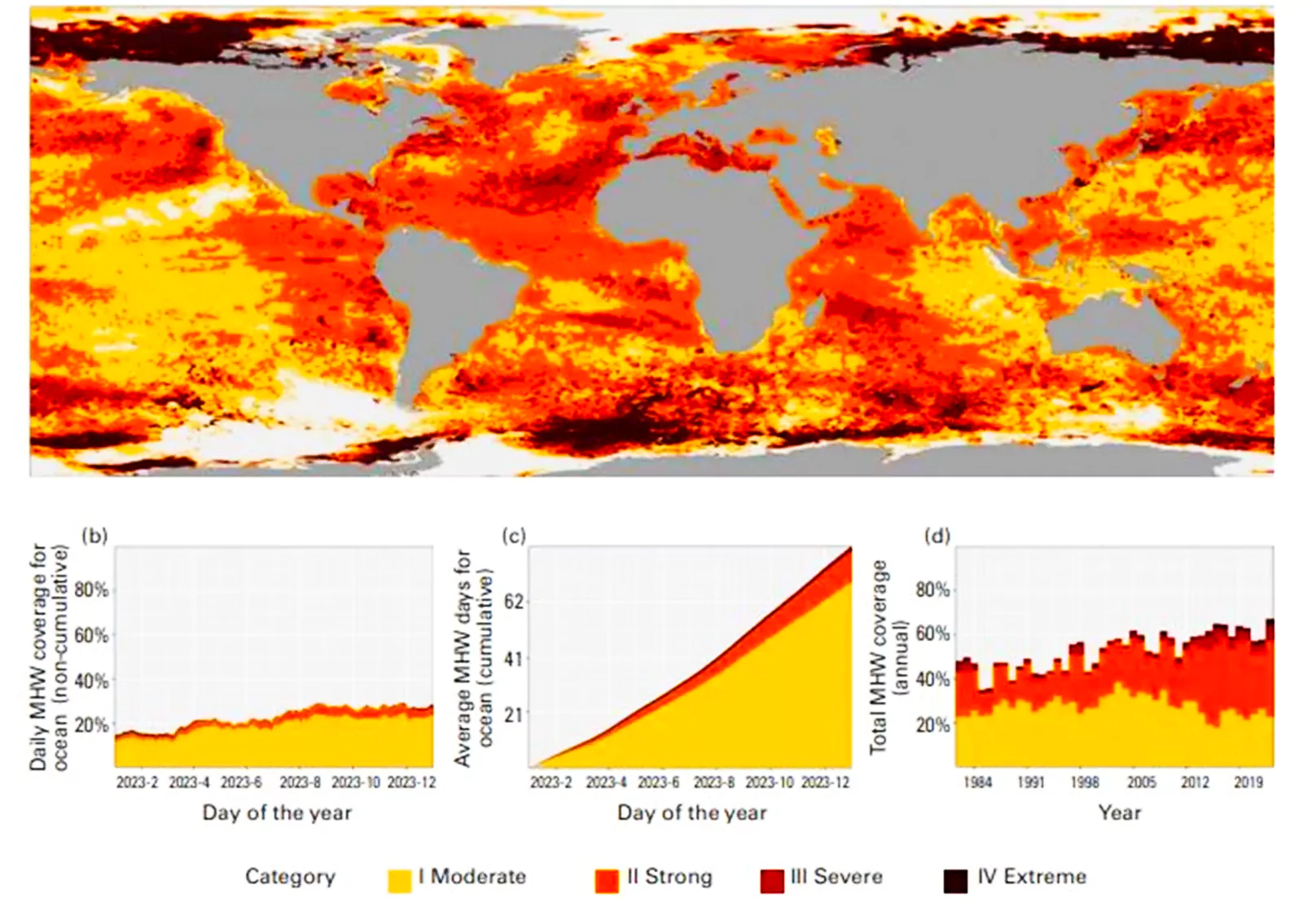
-
Marine Heat Waves:
- Average Daily Marine Heatwave (MHWs) Experience: Due to warmer temperatures, the global ocean experienced an average daily MHWs coverage of 32%.
- Towards the end of 2023, over 90% of the ocean had experienced heatwave conditions at some point during the year.
- Occurrence: MHWs occur when the surface temperature of a particular region of the sea rises to 3 or 4 degrees Celsius above the average temperature for at least five days.
-
Arctic & Antarctic Sea-Ice Extent:
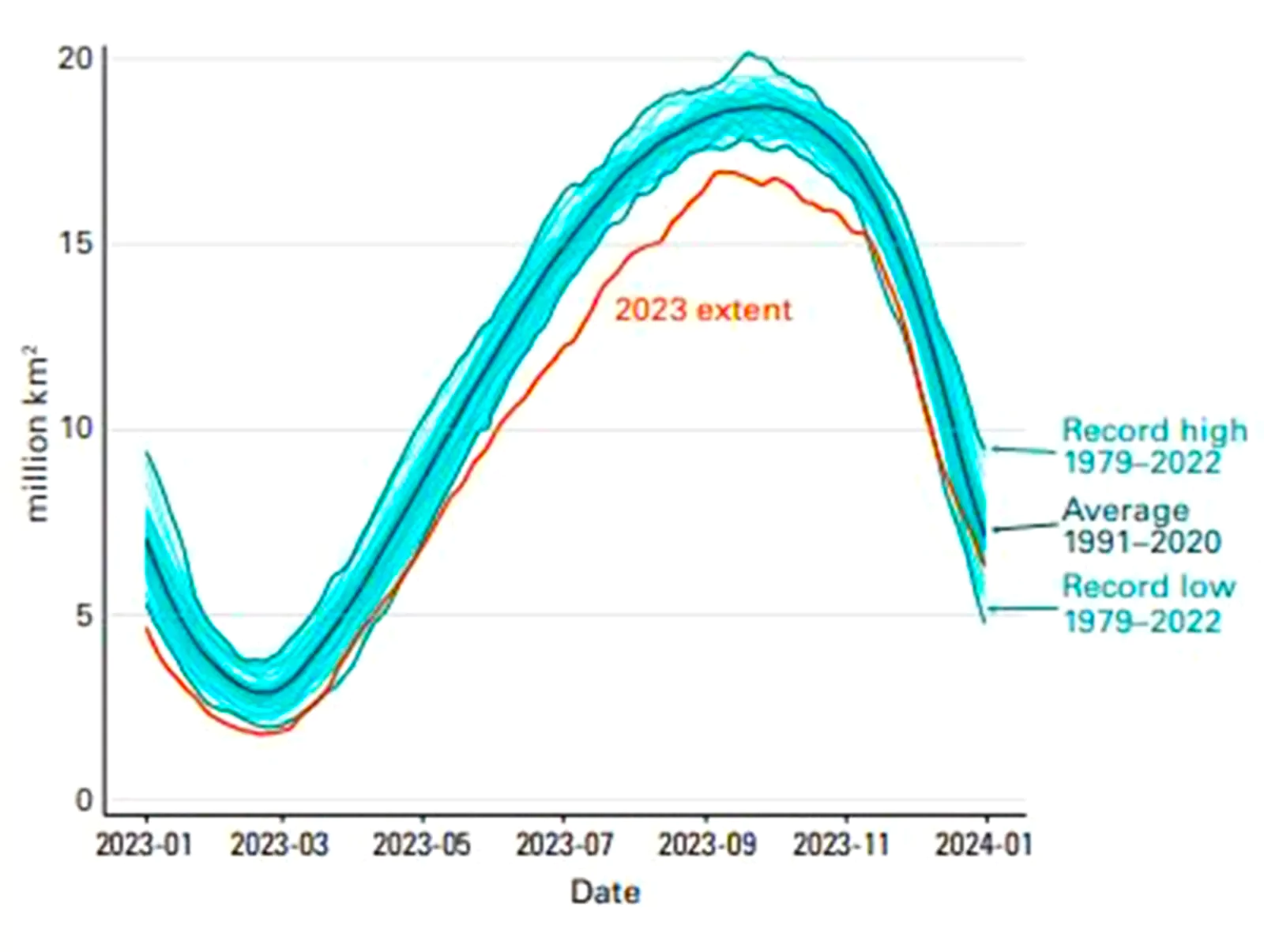
-
- A Record Low: Antarctic sea-ice extent declined to 1.79 million km2 in February 2023, a new record low since the satellite era began in 1979.
- The extent remained at a record low for the time of year from June till early November.
- The annual maximum in September was 16.96 mn km2 (roughly 1.5 mn km2 below the 1991–2020 average) and one mn km2 below the previous record low maximum.
- The Arctic Sea-Ice Extent: It stayed below normal in 2023, with the annual maximum and annual minimum extents being the fifth and sixth lowest in the 45-year satellite record, respectively.
-
Glaciers:
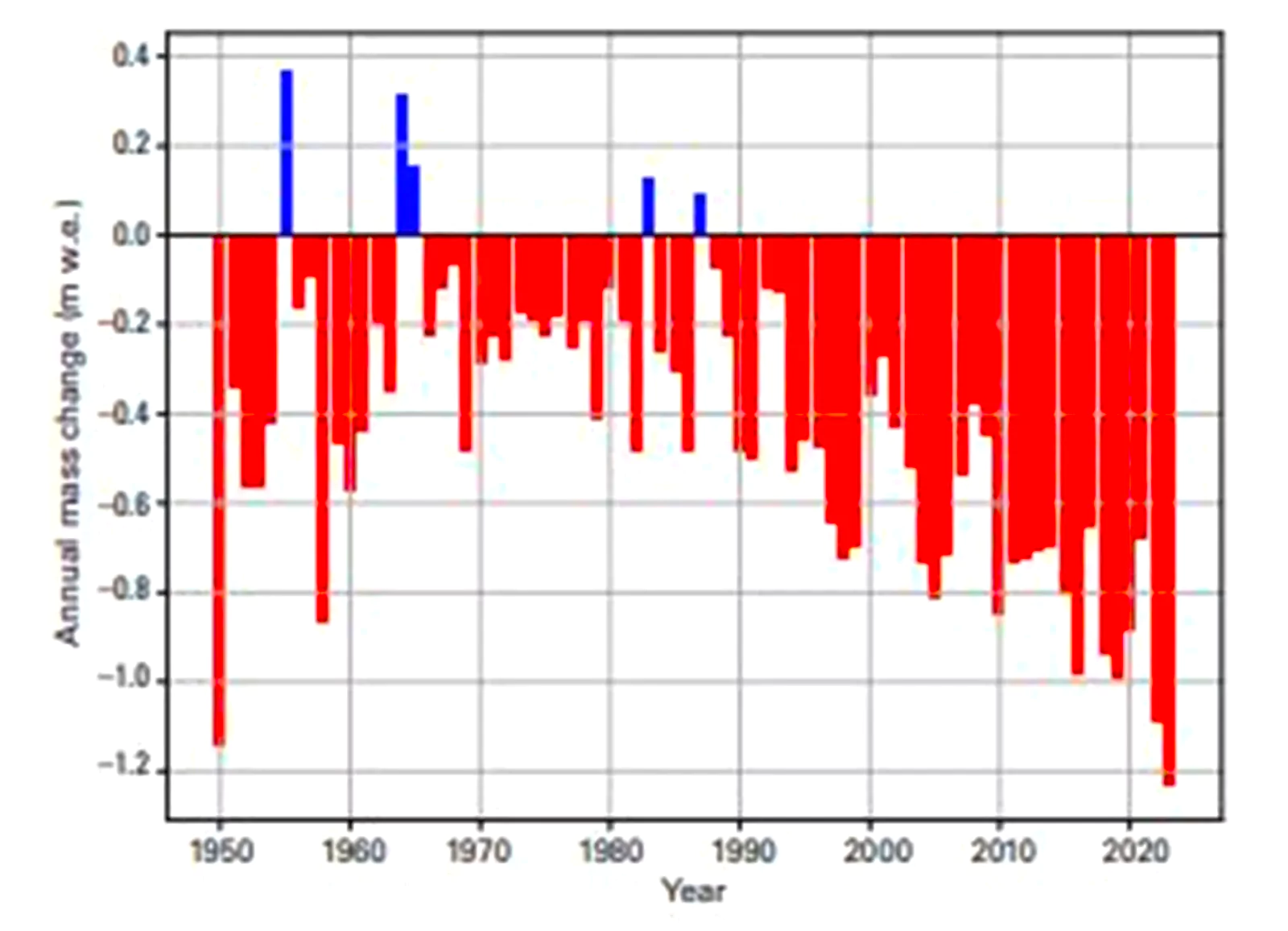
-
- Largest Loss: In the hydrological year 2022-2023, the global set of reference glaciers suffered the largest ice loss on record.
- A New Low in the Annual Mass Balance (AMB): AMB, the amount of mass gained or lost by the glacier and expressed in metres of water equivalent (m w.e.) — of the reference glaciers dropped to a new low in 2022-2023, which was –1.2 m w.e.
- Particularly Impacted: Glaciers in North America and Europe.
- In Switzerland, glaciers lost around 10% of their remaining volume in the past two years.
Impacts of 2023 Weather and Climate Hazards
-
Climate Hazards Witnessed by the World:
- These included major floods, extreme heat and drought, and associated wildfires.
- Droughts: Over 65% of losses due to droughts occurred in the agriculture sector, including crop and livestock production losses.
- Floods, Storms & Cyclones: Around 20% of losses were traced back to agriculture.
- Example: The temperature records that coincide with an ongoing El Nino event was associated with below-normal monsoon rainfall in India as well as an absence of Western Disturbances in the winter that contributed to record-breaking heat in southern India during January and February.
-
Social Crisis:
- Weather and climate hazards have compounded concerns over food security, population displacements and impacts on vulnerable populations in 2023.
- Example: Libya was already facing a food crisis in July 2023, and was hit by Storm Daniel in September that brought heavy rainfall and flooded nearly 3,000 hectares of cropland, particularly in the Almarj and Derna regions — the main cropland areas in the eastern part of the country and key sources of livelihoods.
Crisis of Displacement in 2023
- In Asia: Tropical Cyclone Mocha was one of the most intense cyclones ever observed in the Bay of Bengal. Bangladesh’s Cox’s Bazar, the world’s largest refugee settlement, relocated more than 29,000 people.
- In Syria: Snowstorms and floods led to displacements while these people were already affected by the country’s long-running conflict.
- In Somalia: The ongoing drought resulted in some 531,000 displacements in 2023 in addition to 653,000 displacements primarily caused by conflict and then subsequent flooding during the rainy season displaced more than a million people.
- In Pakistan: The 2022 monsoon floods triggered the largest disaster displacement event in a decade, which continued in 2023. In June 2023, some districts experienced heavy rainfall and resulted in waterborne and vector-borne diseases.
|
-
Inequality Crisis:
- The climate crisis is humanity’s defining challenge and is closely intertwined with the inequality crisis — as witnessed by growing food insecurity, population displacement and biodiversity loss.
-
Challenge Against Sustainable Development Goals (SDGs) Achievement:
- Migration and displacement due to climate-related shocks and stresses affect people’s livelihoods which affect various following sustainable development goals (SDG):
- SDG1: Poverty, SDG2: Hunger, SDG3: Direct threats to their lives and well-being, SDG4: Limited access to quality education, SDG5: Pre-existing gender and socio-economic inequalities, SDG6: Water and sanitation, SDG7: Clean Energy & SDG 10: Widening inequality gaps
-
Economic Losses:
- Globally, the yearly economic losses from climate and weather-related disasters have increased since the dawn of the 21st century.
-
Food & Nutrition Crisis:
- Globally, acute food insecurity has more than doubled, from 149 million people affected before the COVID-19 pandemic to 333 million in 2023.
- The current global food and nutrition crisis is the largest in modern human history.
- Reason of High Global Food Insecurity: Protracted conflicts, economic downturns and high food prices, further exacerbated by high costs of agricultural inputs driven by ongoing and widespread conflict around the world.
- Example: Cyclone Mocha, with an intensification of conflict and record-high food prices, also severely aggravated acute food insecurity.
-
Wildfires:
-
- It affected parts of Hawaii, Canada and Europe, which led to loss of life, the destruction of homes and large-scale air pollution.
Way Forward
- Support to National Meteorological and Hydrological Services (NMHS): There is a need to increase the support for NMHS to provide information services to ensure the next generation of Nationally Determined Contributions are based on science.
- Effective Nationally Determined Contributions (NDCs): NDCs need to be based on science to effectively cut greenhouse gas emissions and transition to renewable energy sources.Adequate Financing: The need of the hour is to secure adequate financing at COP-29 (to be held in Baku, Azerbaijan) to support the implementation of national climate plans, including funding for mitigation and adaptation measures, technology transfer, capacity-building initiatives, and resilience-building efforts, particularly in developing countries.
About Nationally Determined Contributions (NDCs)
- NDCs refer to the commitments made by countries to lay out a time-bound programme to cut GHG emissions, primarily by reducing reliance on fossil fuels and transitioning to renewable energy sources such as solar, wind and hydropower.
About National Meteorological and Hydrological Services (NMHS)
- NMHSs are the official authoritative source, and in most countries, a single voice, on weather warnings in their respective countries, and, in many, they are also responsible for climate, hydrology, air quality, seismic and tsunami warnings and for space weather.
|
- Promote Sustainable Practices: Governments, businesses and individuals must promote sustainable practices. This can range from waste management and water conservation to promoting circular economies that reduce waste and overconsumption.
- Promote Climate Research and Innovation: There is a need to invest and research more on climate science to understand the impacts better and develop innovative solutions.
- There is an urgent need to support and promote advancements in clean energy technologies, carbon capture techniques, and other breakthroughs that can mitigate climate change.
- There is an urgent need to develop and invest more on early warning systems, better infrastructure and implementing climate-smart agriculture.
- Education and Awareness: Raising awareness about the impacts of climate change and educating the public about sustainable living practices is desirable and required.
- Individuals need to adopt more environmentally friendly practices for climate action.
- Cooperation and Commitment: Addressing climate change requires global cooperation and commitment to ambitious climate goals such as in line with the Paris Agreement.
- Developed nations should support developing nations to enable them to adapt and transition to a low-carbon economy.
Conclusion
The Earth is experiencing unprecedented changes that are leading to more frequent and intense extreme weather events, food insecurity, and displacement of vulnerable populations. To mitigate the impacts of climate change and adapt to the new reality, it is crucial to scale up climate finance and close the financing gap.
Also Read: State Of Global Water Resources Report 2022: By WMO
| Prelims PYQ (2023):
Consider the following statements:
Statement-I: Carbon markets are likely to be one of the most widespread tools in the fight against climate change.
Statement-II: Carbon markets transfer resources from the private sector to the State.
Which one of the following is correct in respect of the above statements?
(a) Both Statement-I and Statement-II are correct and StatementII is the correct explanation for Statement-I
(b) Both Statement-I and Statement-II are correct and StatementII is not the correct explanation for Statement-I
(c) Statement-I is correct but StatementII is incorrect
(d) Statement-I is incorrect but Statement-II is correct.
Ans: (a) |
To get PDF version, Please click on "Print PDF" button.
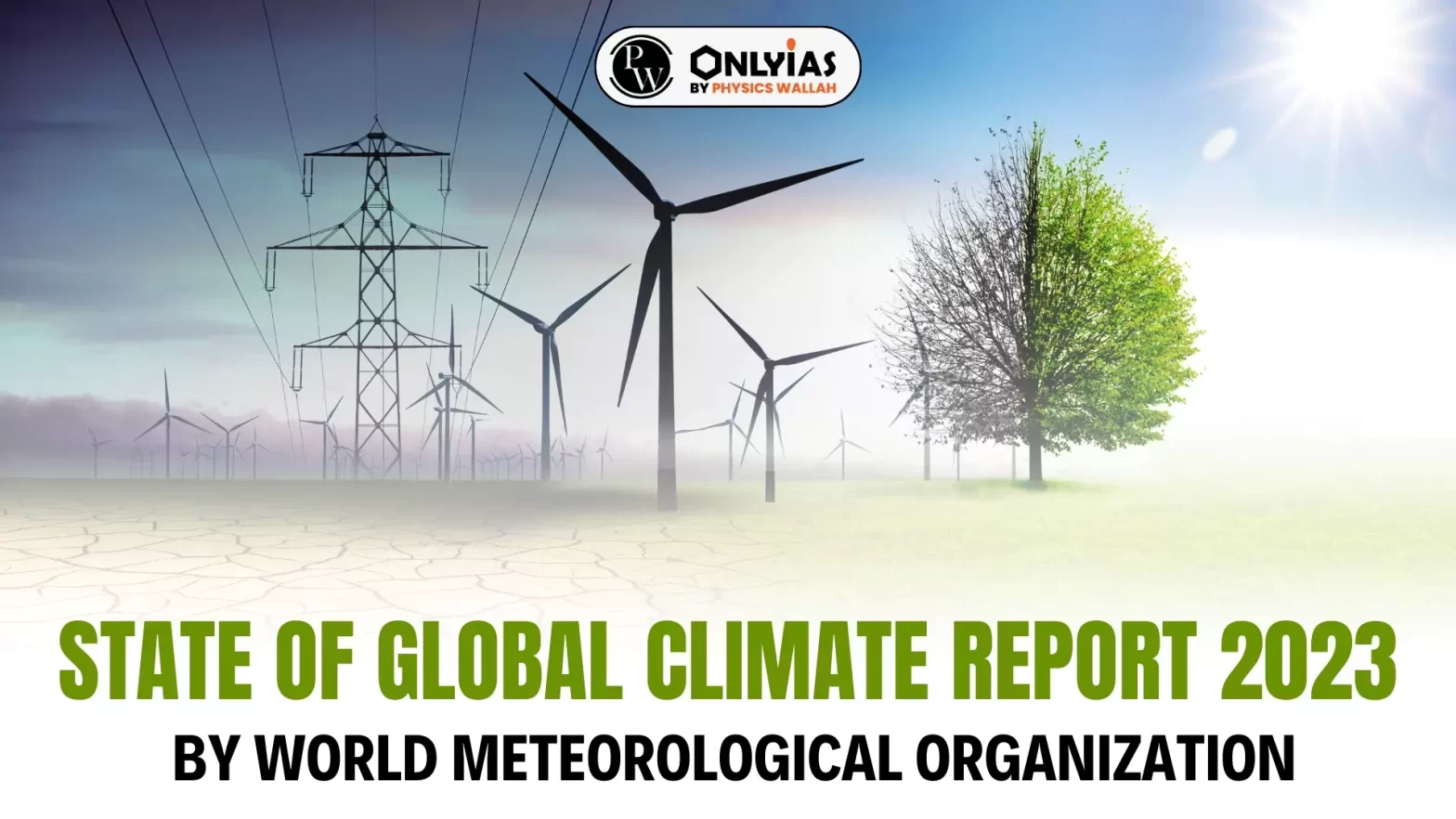

 In an average scenario for a 1.5°C pathway, annual climate finance investments need to grow more than six times, reaching almost USD 9 trillion by 2030 and a further USD 10 trillion through 2050.
In an average scenario for a 1.5°C pathway, annual climate finance investments need to grow more than six times, reaching almost USD 9 trillion by 2030 and a further USD 10 trillion through 2050.





